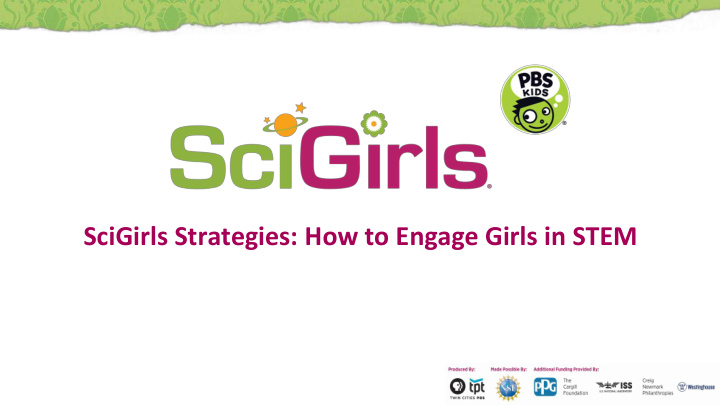



SciGirls Strategies: How to Engage Girls in STEM
Agenda ● SciGirls Overview ● Rationale - What the data shows ● Framing the SciGirls Strategies ● The SciGirls Strategies ● Additional Resources ● Questions
The Big Idea
Our Approach • On TV – national PBS Kids series • Online – PBS Kids website with games and videos • On the Ground – activities and professional development
On TV
Online
On The Ground www.scigirlsconnect.org
Rationale What the data shows Let’s look at the data for girls and women in STEM.
Rationale GPAs in Math and Science SOURCE: U.S. Department of Education, Institute of Education Sciences, National Center for Education Statistics, High School Transcript Study (HSTS), various years, 1990-2009.
Rationale SOURCE: U.S. Department of Education, Institute of Education Sciences, National Center for Education Statistics, 2014.
Rationale SOURCE: U.S. Department of Education, Institute of Education Sciences, National Center for Education Statistics, 2017.
Rationale What does it all mean? • Boys and girls do not display a significant difference in their abilities in STEM. The cause of the gender gap is social and environmental. • Differences consistently appear in girls’ interest and confidence in STEM subjects, starting at a very young age. • These differences can be linked to a negative self-perception , enhanced by stereotypes.
The SciGirls Strategies Fostering girls’ STEM identity The strategies are designed to instill confidence and persistence, and motivate girls to develop a STEM identity STEM identity: refers to a person’s sense of who they are, want to be, and what they believe they are capable of in relation to STEM.
Updating the Strategies The process ● Research: Conducted extensive review of the literature focused on engaging girls in STEM, previous SciGirls Strategies, STEM identity, and culturally responsive teaching practices ● Practice: Informed by SciGirls educators’ experiences and feedback via previous SciGirls project evaluations and pilot testing of updated Strategies
Framing the SciGirls Strategies • STEM for ALL Learning Environment • Culturally Responsive Teaching Strategies
STEM for All Learning Environment • Inclusive learning environment that looks and feels inviting and allows girls to feel they belong • Comfortable, personally meaningful, collegial, supportive and culturally responsive
Culturally Responsive Teaching Lifelong process of using cultural knowledge , prior experiences , and performance styles of diverse students to make learning more appropriate and effective for students. (Gay, 2013)
Framing the SciGirls Strategies STEM for all learning environment and culturally responsive teaching practices frame all of the SciGirls Strategies .
SciGirls Strategies 1. Connect STEM experiences to girls’ lives.
SciGirls Strategies 2. Support girls as they investigate questions and solve problems using STEM practices.
SciGirls Strategies 3. Empower girls to embrace struggle, overcome challenges, and increase self-confidence in STEM.
SciGirls Strategies 4. Encourage girls to identify and challenge STEM stereotypes.
SciGirls Strategies 5. Emphasize that STEM is collaborative, social, and community-oriented.
SciGirls Strategies 6. Provide opportunities for girls to interact with and learn from diverse STEM role models.
FabFems Website FabFems is an international, online, searchable directory of women STEM professionals interested in outreach to girls Audience : • Role Models • Girl-Serving Programs • Parents and Girls www.fabfems.org
Educator resources on scigirlsconnect.org Download videos, activities, and other resources to enhance your program!
Activity Guides www.scigirlsconnect.org
Bilingual resources for educators and families
Looking for more? Questions? SciGirls Activities, Videos, and more: scigirlsconnect.org scigirlstv @SciGirls This material is based upon work supported by the National Science Foundation under Grant No. HRD-1103016. Any opinions, findings, and conclusions or recommendations expressed in this material are those of the author(s) and do not necessarily reflect the views of the National Science Foundation.
Recommend
More recommend